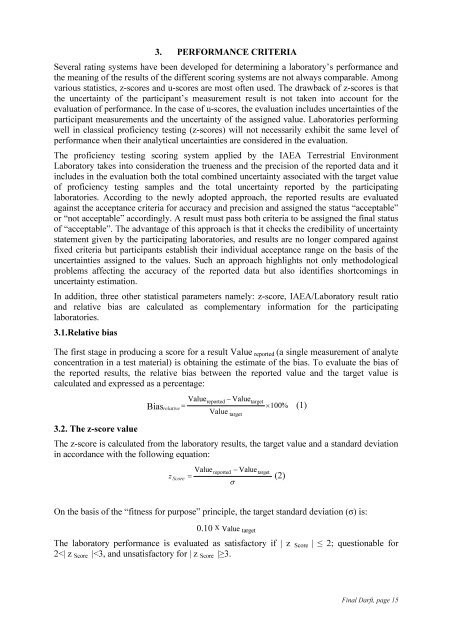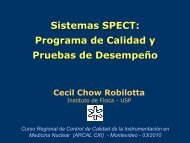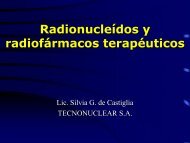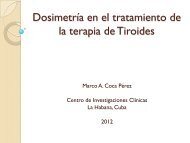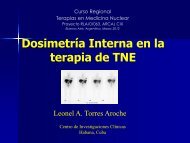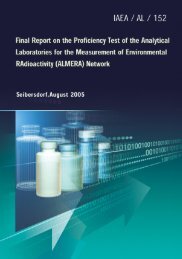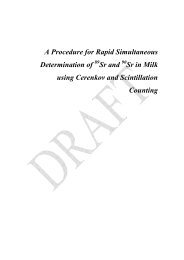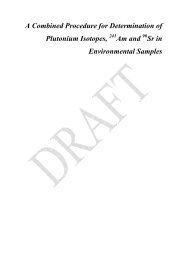Worldwide Open Proficiency Test: Determination of ... - Nucleus - IAEA
Worldwide Open Proficiency Test: Determination of ... - Nucleus - IAEA
Worldwide Open Proficiency Test: Determination of ... - Nucleus - IAEA
Create successful ePaper yourself
Turn your PDF publications into a flip-book with our unique Google optimized e-Paper software.
3. PERFORMANCE CRITERIA<br />
Several rating systems have been developed for determining a laboratory’s performance and<br />
the meaning <strong>of</strong> the results <strong>of</strong> the different scoring systems are not always comparable. Among<br />
various statistics, z-scores and u-scores are most <strong>of</strong>ten used. The drawback <strong>of</strong> z-scores is that<br />
the uncertainty <strong>of</strong> the participant’s measurement result is not taken into account for the<br />
evaluation <strong>of</strong> performance. In the case <strong>of</strong> u-scores, the evaluation includes uncertainties <strong>of</strong> the<br />
participant measurements and the uncertainty <strong>of</strong> the assigned value. Laboratories performing<br />
well in classical pr<strong>of</strong>iciency testing (z-scores) will not necessarily exhibit the same level <strong>of</strong><br />
performance when their analytical uncertainties are considered in the evaluation.<br />
The pr<strong>of</strong>iciency testing scoring system applied by the <strong>IAEA</strong> Terrestrial Environment<br />
Laboratory takes into consideration the trueness and the precision <strong>of</strong> the reported data and it<br />
includes in the evaluation both the total combined uncertainty associated with the target value<br />
<strong>of</strong> pr<strong>of</strong>iciency testing samples and the total uncertainty reported by the participating<br />
laboratories. According to the newly adopted approach, the reported results are evaluated<br />
against the acceptance criteria for accuracy and precision and assigned the status “acceptable”<br />
or “not acceptable” accordingly. A result must pass both criteria to be assigned the final status<br />
<strong>of</strong> “acceptable”. The advantage <strong>of</strong> this approach is that it checks the credibility <strong>of</strong> uncertainty<br />
statement given by the participating laboratories, and results are no longer compared against<br />
fixed criteria but participants establish their individual acceptance range on the basis <strong>of</strong> the<br />
uncertainties assigned to the values. Such an approach highlights not only methodological<br />
problems affecting the accuracy <strong>of</strong> the reported data but also identifies shortcomings in<br />
uncertainty estimation.<br />
In addition, three other statistical parameters namely: z-score, <strong>IAEA</strong>/Laboratory result ratio<br />
and relative bias are calculated as complementary information for the participating<br />
laboratories.<br />
3.1.Relative bias<br />
The first stage in producing a score for a result Value reported (a single measurement <strong>of</strong> analyte<br />
concentration in a test material) is obtaining the estimate <strong>of</strong> the bias. To evaluate the bias <strong>of</strong><br />
the reported results, the relative bias between the reported value and the target value is<br />
calculated and expressed as a percentage:<br />
3.2. The z-score value<br />
Bias<br />
Valuereported<br />
− Valuetarget<br />
relative =<br />
× 100%<br />
(1)<br />
Value<br />
The z-score is calculated from the laboratory results, the target value and a standard deviation<br />
in accordance with the following equation:<br />
target<br />
Value<br />
Value −<br />
reported<br />
target<br />
z Score =<br />
(2)<br />
On the basis <strong>of</strong> the “fitness for purpose” principle, the target standard deviation (σ) is:<br />
σ<br />
0.10 x Value target<br />
The laboratory performance is evaluated as satisfactory if | z Score | ≤ 2; questionable for<br />
2


